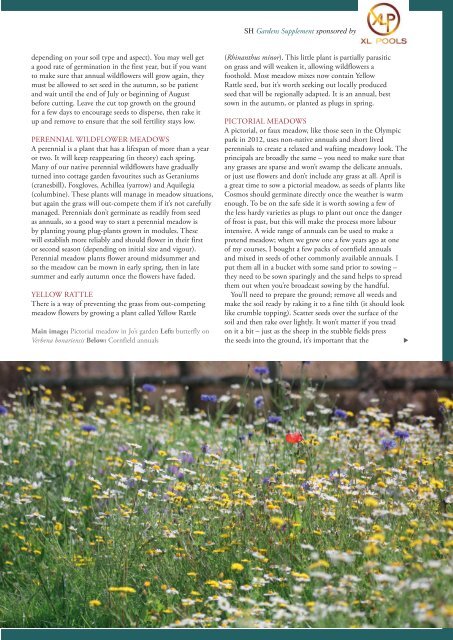Surrey Homes | SH66 | April 2020 | Gardens supplement
The lifestyle magazine for Surrey - Inspirational Interiors, Fabulous Fashion, Delicious Dishes
The lifestyle magazine for Surrey - Inspirational Interiors, Fabulous Fashion, Delicious Dishes
Create successful ePaper yourself
Turn your PDF publications into a flip-book with our unique Google optimized e-Paper software.
SH <strong>Gardens</strong> Supplement sponsored by<br />
depending on your soil type and aspect). You may well get<br />
a good rate of germination in the first year, but if you want<br />
to make sure that annual wildflowers will grow again, they<br />
must be allowed to set seed in the autumn, so be patient<br />
and wait until the end of July or beginning of August<br />
before cutting. Leave the cut top growth on the ground<br />
for a few days to encourage seeds to disperse, then rake it<br />
up and remove to ensure that the soil fertility stays low.<br />
Perennial wildflower meadows<br />
A perennial is a plant that has a lifespan of more than a year<br />
or two. It will keep reappearing (in theory) each spring.<br />
Many of our native perennial wildflowers have gradually<br />
turned into cottage garden favourites such as Geraniums<br />
(cranesbill), Foxgloves, Achillea (yarrow) and Aquilegia<br />
(columbine). These plants will manage in meadow situations,<br />
but again the grass will out-compete them if it’s not carefully<br />
managed. Perennials don’t germinate as readily from seed<br />
as annuals, so a good way to start a perennial meadow is<br />
by planting young plug-plants grown in modules. These<br />
will establish more reliably and should flower in their first<br />
or second season (depending on initial size and vigour).<br />
Perennial meadow plants flower around midsummer and<br />
so the meadow can be mown in early spring, then in late<br />
summer and early autumn once the flowers have faded.<br />
Yellow Rattle<br />
There is a way of preventing the grass from out-competing<br />
meadow flowers by growing a plant called Yellow Rattle<br />
Main image; Pictorial meadow in Jo’s garden Left: butterfly on<br />
Verbena bonariensis Below: Cornfield annuals<br />
(Rhinanthus minor). This little plant is partially parasitic<br />
on grass and will weaken it, allowing wildflowers a<br />
foothold. Most meadow mixes now contain Yellow<br />
Rattle seed, but it’s worth seeking out locally produced<br />
seed that will be regionally adapted. It is an annual, best<br />
sown in the autumn, or planted as plugs in spring.<br />
Pictorial Meadows<br />
A pictorial, or faux meadow, like those seen in the Olympic<br />
park in 2012, uses non-native annuals and short lived<br />
perennials to create a relaxed and wafting meadowy look. The<br />
principals are broadly the same – you need to make sure that<br />
any grasses are sparse and won’t swamp the delicate annuals,<br />
or just use flowers and don’t include any grass at all. <strong>April</strong> is<br />
a great time to sow a pictorial meadow, as seeds of plants like<br />
Cosmos should germinate directly once the weather is warm<br />
enough. To be on the safe side it is worth sowing a few of<br />
the less hardy varieties as plugs to plant out once the danger<br />
of frost is past, but this will make the process more labour<br />
intensive. A wide range of annuals can be used to make a<br />
pretend meadow; when we grew one a few years ago at one<br />
of my courses, I bought a few packs of cornfield annuals<br />
and mixed in seeds of other commonly available annuals. I<br />
put them all in a bucket with some sand prior to sowing –<br />
they need to be sown sparingly and the sand helps to spread<br />
them out when you’re broadcast sowing by the handful.<br />
You’ll need to prepare the ground; remove all weeds and<br />
make the soil ready by raking it to a fine tilth (it should look<br />
like crumble topping). Scatter seeds over the surface of the<br />
soil and then rake over lightly. It won’t matter if you tread<br />
on it a bit – just as the sheep in the stubble fields press<br />
the seeds into the ground, it’s important that the<br />
<br />
7 wealdentimes.co.uk<br />
surrey-homes.co.uk


















